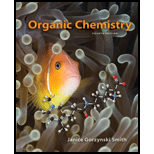
Concept explainers
Locate the isoprene units in each compound.
a. c.
c. 
b.  d.
d. 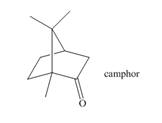
(a)
Interpretation: The isoprene units in the given compound are to be located.
Concept introduction: An isoprene unit possesses following properties.
➢ It may either consist of
➢ It is always connected by one or more
➢ Each isoprene unit is consist of
➢ While locating an isoprene unit, the presence of heteroatoms is ignored.
Answer to Problem 30.11P
The isoprene units in the given terpene (geraniol) are located as,
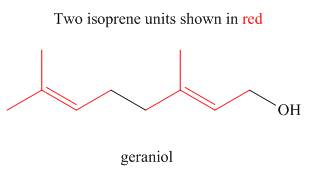
Explanation of Solution
Terpenes are composed of repeating five-carbon units. These units are called isoprene units.
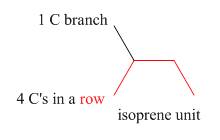
Figure 1
An isoprene unit possesses following properties.
➢ It involves one branched carbon and
➢ It may either consist of
➢ It is always connected by one or more
➢ Each isoprene unit is consist of
➢ While locating an isoprene unit, the presence of heteroatoms is ignored.
The isoprene units in the given terpene (geraniol) are located as,

Figure 2
The isoprene units in the given terpene (geraniol) are located in Figure 2.
(b)
Interpretation: The isoprene units in the given compound are to be located.
Concept introduction: An isoprene unit possesses following properties.
➢ It may either consist of
➢ It is always connected by one or more
➢ Each isoprene unit is consist of
➢ While locating an isoprene unit, the presence of heteroatoms is ignored.
Answer to Problem 30.11P
The isoprene units in the given terpene (vitamin A) are located as,
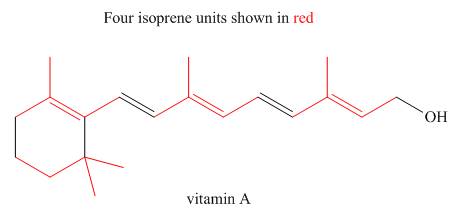
Explanation of Solution
Terpenes are composed of repeating five-carbon units. These units are called isoprene units.

Figure 1
An isoprene unit possesses following properties.
➢ It involves one branched carbon and
➢ It may either consist of
➢ It is always connected by one or more
➢ Each isoprene unit is consist of
➢ While locating an isoprene unit, the presence of heteroatoms is ignored.
The isoprene units in the given terpene (vitamin A) are located as,

Figure 3
The isoprene units in the given terpene (vitamin A) are located in Figure 3.
(c)
Interpretation: The isoprene units in the given compound are to be located.
Concept introduction: An isoprene unit possesses following properties.
➢ It may either consist of
➢ It is always connected by one or more
➢ Each isoprene unit is consist of
➢ While locating an isoprene unit, the presence of heteroatoms is ignored.
Answer to Problem 30.11P
The isoprene units in the given terpene (grandisol) are located as,
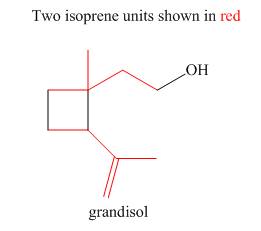
Explanation of Solution
Terpenes are composed of repeating five-carbon units. These units are called isoprene units.

Figure 1
An isoprene unit possesses following properties.
➢ It involves one branched carbon and
➢ It may either consist of
➢ It is always connected by one or more
➢ Each isoprene unit is consist of
➢ While locating an isoprene unit, the presence of heteroatoms is ignored.
The isoprene units in the given terpene (grandisol) are located as,

Figure 4
The isoprene units in the given terpene (grandisol) are located in Figure 4.
(d)
Interpretation: The isoprene units in the given compound are to be located.
Concept introduction: An isoprene unit possesses following properties.
➢ It may either consist of
➢ It is always connected by one or more
➢ Each isoprene unit is consist of
➢ While locating an isoprene unit, the presence of heteroatoms is ignored.
Answer to Problem 30.11P
The isoprene units in the given terpene (camphor) are located as,

Explanation of Solution
Terpenes are composed of repeating five-carbon units. These units are called isoprene units.

Figure 1
An isoprene unit possesses following properties.
➢ It involves one branched carbon and
➢ It may either consist of
➢ It is always connected by one or more
➢ Each isoprene unit is consist of
➢ While locating an isoprene unit, the presence of heteroatoms is ignored.
The isoprene units in the given terpene (camphor) are located as,

Figure 5
The isoprene units in the given terpene (camphor) are located in Figure 5.
Want to see more full solutions like this?
Chapter 30 Solutions
Connect Access Card For Organic Chemistry
- Draw all constitutional isomers formed when X is treated with NBS + hv.arrow_forwardD-Arabinose can exist in both pyranose and furanose forms.a. Draw the a and ß anomers of D-arabinofuranose.b. Draw the a and ß anomers of D-arabinopyranosearrow_forwardDetermine the product formed when compound A is treated with each reagent.arrow_forward
- Not all aldehyde give a positve Bendicts test. Which of the follwing aldehydes do? a. d. b. e. c.arrow_forward(a) Give an acceptable name for compound A. (b) Draw the organic products formed when A is treated with each reagent: [1] H3O+; [2] −OH, H2O; [3] CH3CH2CH2MgBr (excess), then H2O; [4] LiAlH4, then H2O.arrow_forwardD-Arabinose can exist in both pyranose and furanose forms. a. Draw the α and β anomers of D-arabinofuranose. b. Draw the α and β anomers of D-arabinopyranose.arrow_forward
- Draw a stepwise mechanism for the attached isomerization.arrow_forwardDraw a stepwise mechanism for the attached reaction that forms ether D. D can be converted to the antidepressant fluoxetine (trade name Prozac) in a single steparrow_forwardDraw the organic products formed when attached allylic alcohol A is treated with following reagent. PCCarrow_forward
 Organic ChemistryChemistryISBN:9781305580350Author:William H. Brown, Brent L. Iverson, Eric Anslyn, Christopher S. FootePublisher:Cengage Learning
Organic ChemistryChemistryISBN:9781305580350Author:William H. Brown, Brent L. Iverson, Eric Anslyn, Christopher S. FootePublisher:Cengage Learning Chemistry for Today: General, Organic, and Bioche...ChemistryISBN:9781305960060Author:Spencer L. Seager, Michael R. Slabaugh, Maren S. HansenPublisher:Cengage Learning
Chemistry for Today: General, Organic, and Bioche...ChemistryISBN:9781305960060Author:Spencer L. Seager, Michael R. Slabaugh, Maren S. HansenPublisher:Cengage Learning

